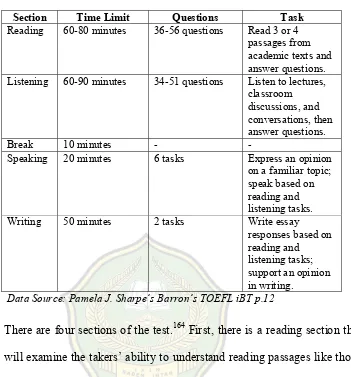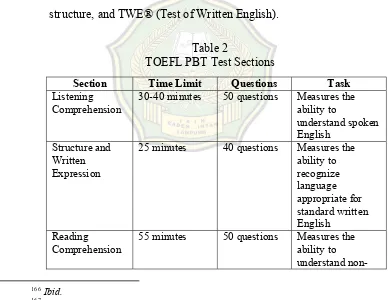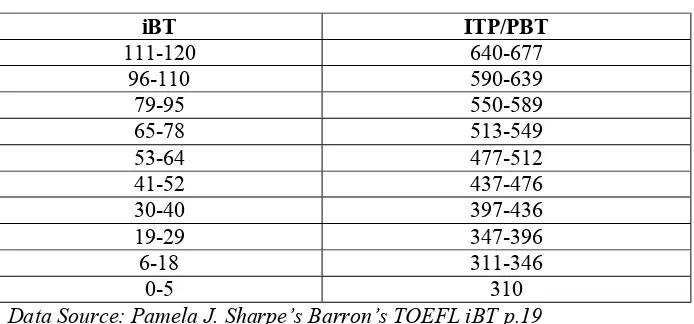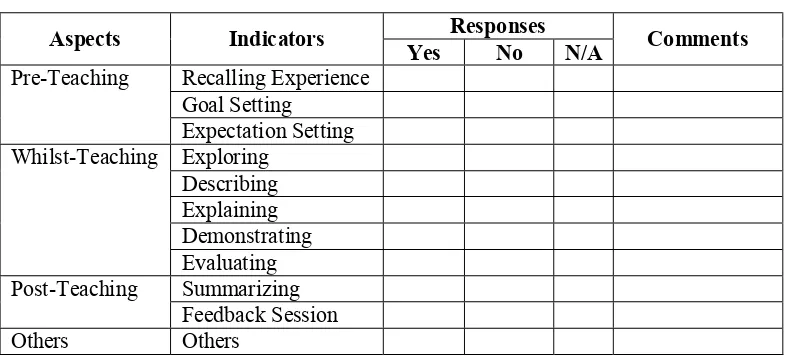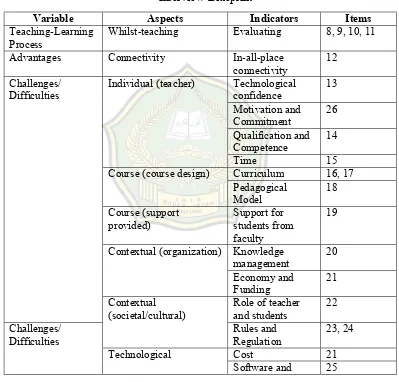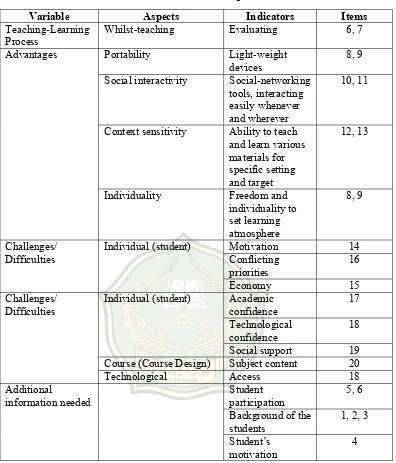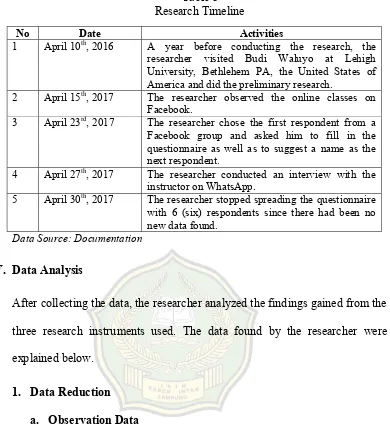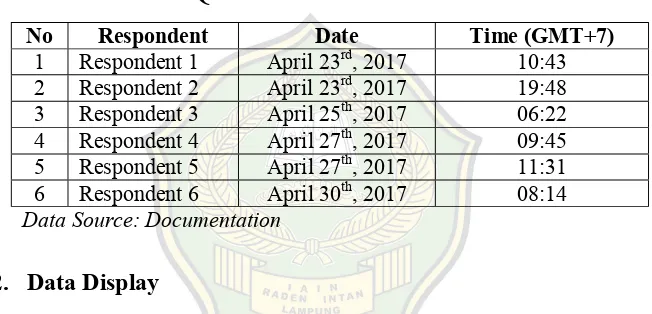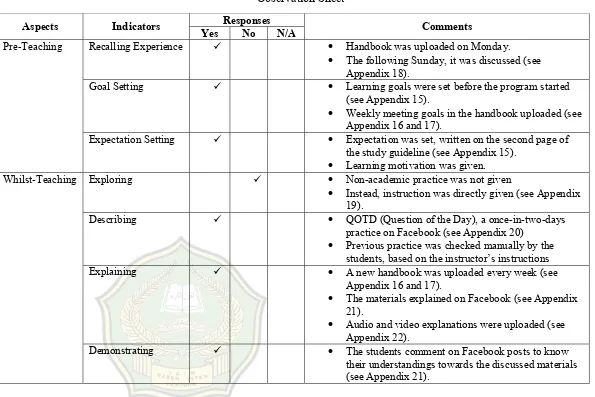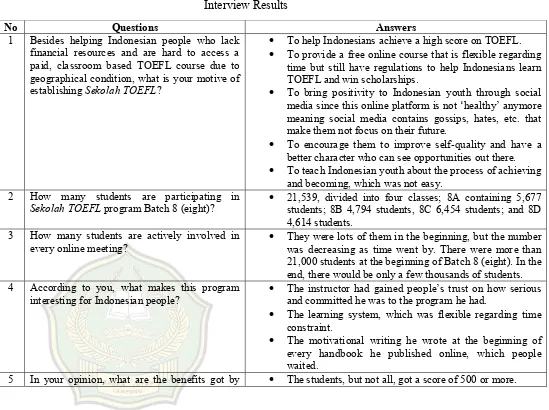AN ANALYSIS OF THE ONLINE LEARNING SYSTEM (OLS) FOR THE STUDENTS OF SEKOLAH TOEFL
A Thesis
Submitted as a Partial Fulfillment of The Requirements for S1 Degree
By
ALVIN KURNIA SANDY NPM. 1311040025
English Education Study Program
TARBIYAH AND TEACHER TRAINING FACULTY ISLAMIC UNIVERSITY OFRADEN INTAN LAMPUNG
AN ANALYSIS OF THE ONLINE LEARNING SYSTEM (OLS) FOR THE STUDENTS OF SEKOLAH TOEFL
A Thesis
Submitted as a Partial Fulfillment of The Requirements for S1 Degree
By
ALVIN KURNIA SANDY NPM. 1311040025
English Education Study Program
Advisor : Bambang Irfani, M.Pd Co Advisor : Deri Herdawan, M.Pd
TARBIYAH AND TEACHER TRAINING FACULTY ISLAMIC UNIVERSITY OFRADEN INTAN LAMPUNG
DECLARATION
At this moment, I declare that this undergraduate thesis entitled, “An Analysis of the Online Learning System (OLS) for the Students of Sekolah TOEFL” is entirely my work. I am acutely aware of the fact that I have quoted some statements and ideas
of various sources and I duly acknowledged them in this thesis.
Bandar Lampung, June 22nd, 2017 The Researcher,
KEMENTERIAN AGAMA REPUBLIK INDONESIA
UNIVERSITAS ISLAM NEGERI RADEN INTAN LAMPUNG FAKULTAS TARBIYAH DAN KEGURUAN
Alamat: Jl. Letkol H. Endro Suratmin Sukarame I Bandar Lampung (0721) 703260 ADMISSION
A thesis entitiled AN ANALYSIS OF THE ONLINE LEARNING SYSTEM (OLS) FOR THE STUDENTS OF SEKOLAH TOEFL, by: ALVIN KURNIA SANDY, NPM: 1311040025, English Education Study Program, was tested and defended in the examination session on Thursday, June 22nd, 2017.
Board of Examiners:
The Chairperson : Meisuri, M.Pd ( )
The Secretary : Septa Aryanika, M.Pd ( )
The Primary Examiner : Istiqomah Nur Rahmawati, M.Pd ( )
The First Co-Examiner : Bambang Irfani, M.Pd ( )
The Second Co-Examiner : Deri Herdawan, M.Pd ( )
The Dean of
Tarbiyah and Teacher Training Faculty
KEMENTERIAN AGAMA REPUBLIK INDONESIA UNIVERSITAS ISLAM NEGERI RADEN INTAN LAMPUNG
FAKULTAS TARBIYAH DAN KEGURUAN
Alamat: Jl. Letkol H. Endro Suratmin Sukarame Bandar Lampung (0721) 703260
APPROVAL
Title : AN ANALYSIS OF THE ONLINE LEARNING
SYSTEM (OLS) FOR THE STUDENTS OF SEKOLAH TOEFL
Student Name : ALVIN KURNIA SANDY Student Number : 1311040025
Study Program : ENGLISH EDUCATION
Faculty : TARBIYAH AND TEACHER TRAINING FACULTY
APPROVED
To be tested and defended in an examination session at Tarbiyah and Teacher Training Faculty the State Islamic University of Raden Intan Lampung
Advisor Co-Advisor
Bambang Irfani, M.Pd Deri Herdawan, M.Pd
NIP. 1973051720060411001
The Chairperson of
English Education Study Program
ABSTRACT
Nowadays, to gain a minimum score of the standardized English proficiency test called Test of English as a Foreign Language (TOEFL) becomes more and more important since anybody who wants to win scholarships, study abroad, or graduate from university, needs it. Many English courses offer TOEFL preparation classes. However, people who live in disadvantaged conditions, living in geographically remote areas and having no access to skilled-teachers as well as lacking financial resources to learn English at a paid, classroom-based course, find that TOEFL is such a big issue. Sekolah TOEFL, a free TOEFL course delivered through online media, was founded in 2015 as a response to the issue. This program became viral. Until the researcher conducted this study, there were more than 100,000 students registered who were spread in many different places in Indonesia and abroad. This study was conducted to know the teaching and learning process, the advantages as well as the difficulties faced by the students and the instructor. As a result of this study, the researcher found that the teaching and learning process at Sekolah TOEFL was uniquely delivered through three primary platforms including Facebook, WhatsApp, and Weblog. It was well-run and systematic, shown by its relevance to the Indonesian government regulation on the standardized teaching and learning mechanism. This program gave advantages for both the students and the instructor, for example, its portability, individuality, social interactivity, connectivity, and context sensitivity. Moreover, although promising benefits were found, this research revealed that they also faced many challenges in various aspects. The instructor found that government-related regulation, technological confidence, time difference, funding, and material development became issues while the students faced technological and financial issues.
CURRICULUM VITAE
The researcher, who was born in Tanjung Karang, on March 8th, 1996, started studying at MIN 3 Wates Liwa in 2000 but had to move to MIN 6 Jati Agung in
2002 due to his father’s work placement. He graduated from MTs Negeri 2 Bandar
Lampung in 2010 and MAN 1 Bandar Lampung in 2013. He finished his bachelor’s
degree at UIN Raden Intan Lampung majoring in English Education in 2017.
During his university years, he was a member of some organizations including
AIESEC and English Student Association. In those groups, he led and initiated
several social projects in Lampung Province. Since 2015, he had taught English at
MAN 1 Bandar Lampung and various English courses in Lampung. He received the
Global Undergraduate Exchange Scholarship 2015-16 in which he attended Wilson
College in Pennsylvania, the United States, for one academic semester. In the
program, he was actively involved in some university programs and community
events such as Wilson Choir, Muhibbah Cultural Performance, and Chambersburg
Ice Festival. He also did social services in an organization called Chambersburg Inc.
and in a retirement community house, Menno Haven. Upon flying back to Indonesia,
he spoke on Leadership and Scholarship to local as well as international students at
many different universities and organizations in different provinces in Indonesia.
Communications and photography are what he is passionate about besides public
DEDICATION
This thesis is dedicated to:
1. My beloved parents, Mr. Sudirman, S.Pd.I and Mrs. Suswatiningsih; 2. My brother, Syukma Ba’adilla;
3. My alma mater of Islamic State University of Raden Intan Lampung in Bandar Lampung, Indonesia and Wilson College in Pennsylvania, the United States of America;
4. My colleagues at English Education Study Program of Islamic State
MOTTO
“O my sons, go and find out about Joseph and his brother and despair not of relief
from Allah. Indeed, no one despairs of relief from Allah except the disbelieving
people." (Yusuf 12: 87)89
ACKNOWLEDGEMENTS
First and foremost, I would express grateful to the Only God, Allah (SWT), for the chance, guidance, and blessings given, thus I could compose and finish this undergraduate thesis. Peace and salutation may always be sent to Prophet Muhammad, peace be upon him.
This thesis was submittedas a partial fulfillment of the requirements for an education degree in English. I realize that this thesis would not have come to its final form without generous help, support, advice, and prayers of people surround me. Many people have contributed their ideas and time to help me complete this thesis, and it would be impossible to mention all of them. However, I would like to express sincere gratitude and appreciation to the following stakeholders.
1. Dr. H. Chairul Anwar, M.Pd., the Dean of Tarbiyah and Teacher Training Faculty at the Islamic State University of Raden Intan Lampung;
2. Meisuri, M.Pd., the Chairperson of the English Education Study Program at the Islamic State University of Raden Intan Lampung;
Exchange Program, which I participated for a semester in the United States in 2016;
4. Deri Herdawan, M.Pd., the Co-Advisor for his patience with my knowledge gaps in research area;
5. Budi Waluyo, M.A., Ph.D., the Founder and Head of Sekolah TOEFL in Bethlehem, Pennsylvania, the United States of America, for giving me a chance to learn more about the program he ran and for taking me around when I visited him in Bethlehem, Pennsylvania, the United States of America in 2016;
6. All lecturers of the English Education Study Program at the Islamic State University of Raden Intan Lampung although I have not had the opportunity to work with some of them previously, the impact of their work on my study isevident throughout this thesis;
7. My family, who has been kind and supportive to me because getting through this thesis required more than academic support. This work stands as a testament to your unconditional love and encouragement;
9. American Indonesian Exchange Foundation (AMINEF) Team, who had given a chance to me for experiencing American higher education and way of living at Wilson College, Chambersburg, Pennsylvania in Spring Semester 2016; 10. Roya Zahed and Patrick Murphy, the South-East Asia Coordinators for the
Global Undergraduate Exchange Program, and World Learning Team in Washington D.C. who provided me with support so that I could gain most of the program in which I gained countless knowledge, cultural as well as academic experience that was very helpful to me;
11. Kiah Berman, Kay Ackerman, Laura Biesecker, and Sharon Erby, my professors at Wilson College whose teaching style and attitude made a strong impression on me, and I have always carried positive memories of their classes with me. My time at the college has been highly productive and working with them was an extraordinary experience;
12. Khalil Muminov in Tashkent, Uzbekistan and Leydianis Gonzales in Panama City, Panama, my Global Undergraduate Program fellows at Wilson College who made my American experience memorable;
13. Endah Rosa, Kezia Kokeina, Putri Permata Sari, Runi Virzia, Vini Alfarina, and Wa Ode Siti Amanah, 2016 Global Undergraduate Program grantees from Indonesia with whom I spent time sharing about how to deal with many challenges we faced in the States and how fruitful the experience was;
16. All stakeholders I could not mention.
Finally, I have to admit that nobody is perfect and I realize that this project lacks
perfection because of my limited knowledge and ability. So, I truthfully welcome
criticism and suggestion to enhance the quality of this thesis.
Bandar Lampung, 22 June 2017 The Researcher,
TABLE OF CONTENTS
COVER ... i
TITLE ... ii
DECLARATION ... iii
APPROVAL ... iv
ADMISSION ... v
ABSTRACT ... vi
CURRICULUM VITAE ... vii
DEDICATION ... viii
MOTTO ... ix
ACKNOWLEDGEMENTS ... x
TABLE OF CONTENTS ... xiv
LIST OF TABLES ... xvii
LIST OF APPENDICES ... xviii
CHAPTER I: INTRODUCTION ... 1
A. Background of the Problem ... 1
B. Identification of the Problem ... 8
C. Limitation of the Problem ... 8
D. Formulation of the Problem ... 9
E. Objective of the Research ... 10
F. Uses of the Research ... 10
G. Scope of the Research ... 11
CHAPTER II: REVIEW OF LITERATURE... 12
A. Teaching and Learning ... 12
1. Teaching ... 12
2. Learning ... 13
3. Process of Teaching and Learning ... 15
B. Distance Education ... 18
C. Online Learning System ... 20
1. Definition ... 20
2. Difficulties/Challenges ... 22
4. Media ... 32
D. TOEFL ... 36
1. Definition ... 36
2. Types... 37
E. Sekolah TOEFL ... 42
CHAPTER III: RESEARCH METHODOLOGY ... 45
A. Research Design ... 45
B. Research Subject ... 47
C. Data Collecting Technique ... 49
D. Research Instruments ... 50
1. Observation ... 50
2. Interview ... 51
3. Questionnaire ... 53
E. Research Procedure ... 55
F. Trustworthiness of the Data ... 55
1. Time Triangulation ... 56
2. Space Triangulation ... 56
3. Theoretical Triangulation... 56
4. Methodological Triangulation ... 56
5. Investigator Triangulation ... 56
G. Data Analysis ... 57
1. Data Reduction ... 57
2. Data Display ... 58
3. Conclusion Drawing/Verification ... 58
CHAPTER IV: FINDING AND DISCUSSION... 60
A. General Description of the Research Place ... 60
B. Research Mechanism ... 61
C. Data Analysis ... 62
1. Data Reduction ... 62
a. Observation Data ... 62
b. Interview Data ... 63
c. Questionnaire Data ... 63
2. Data Display ... 64
a. Observation ... 64
b. Interview ... 72
c. Questionnaire ... 81
3. Conclusion Drawing ... 94
b. Difficulties ... 96
c. Advantages ... 97
D. Discussion of Findings ... 98
1. Teaching and Learning Process... 98
2. Difficulties ... 100
3. Advantages ... 102
CHAPTER V: CONCLUSION AND SUGGESTION ... 105
A. Conclusion ... 105
B. Suggestion ... 109
REFERENCES ... 110
LIST OF TABLES
Table 1 TOEFL iBT Test Sections ... 37
Table 2 TOEFL PBT Test Sections ... 39
Table 3 TOEFL iBT and PBT Score Comparison ... 41
Table 4 Observation Checklist ... 51
Table 5 Interview Blueprint ... 52
Table 6 Questionnaire Blueprint ... 54
Table 7 Batch 8 (Eight) Students of Sekolah TOEFL ... 60
Table 8 Research Timeline ... 61
Table 9 Questionnaire Submission Timeline ... 64
Table 10 Observation Sheet ... 65
Table 11 Interview Results ... 73
LIST OF APPENDICES
Appendix 1 Observation Timeline ... 117
Appendix 2 Observation Guidelines ... 118
Appendix 3 Interview Guidelines ... 121
Appendix 4 Interview Transcription ... 123
Appendix 5 Questionnaire (English) ... 131
Appendix 6 Questionnaire (Indonesian) ... 132
Appendix 7 Questionnaire Responses (English) ... 137
Appendix 8 Questionnaire Response 1 (Indonesian) ... 142
Appendix 9 Questionnaire Response 2 (Indonesian) ... 147
Appendix 10 Questionnaire Response 3 (Indonesian) ... 152
Appendix 11 Questionnaire Response 4 (Indonesian) ... 157
Appendix 12 Questionnaire Response 5 (Indonesian) ... 162
Appendix 13 Questionnaire Response 6 (Indonesian) ... 167
Appendix 14 Sekolah TOEFL Batch 8 (Eight) Timeline ... 172
Appendix 15 Sekolah TOEFL Study Guideline (Panduan Belajar) ... 174
Appendix 16 Sekolah TOEFL Structure Handbook Week 1 ... 182
Appendix 17 Sekolah TOEFL Written Handbook Week 1 ... 206
Appendix 18 Screenshot of Facebook Group Establishment ... 229
Appendix 19 Screenshot of Exploring Activity ... 230
Appendix 20 Screenshot of Question of the Day (QOTD) ... 231
Appendix 21 Screenshot of Temu Online, Online Class on Facebook ... 233
Appendix 22 Screenshot of Audio and Video Explanation Post ... 242
Appendix 23 Screenshot of Online Class Closing ... 243
Appendix 24 Screenshot of Question and Answer Session ... 244
Appendix 25 Screenshot of Sekolah TOEFL Philosophy Post ... 245
Appendix 26 Screenshot of Free Scholarship E-Books Post ... 246
Appendix 27 Official Research Letter... 247
Appendix 28 Correspondent Research Letter ... 248
CHAPTER I INTRODUCTION
A. Background of the Problem
As of now when everything is spread very quickly, and when people are
urged to be able to communicate globally, the English language plays a
critical role. According to Crystal, English has been learned by many people
to have a good prospect in the community of international world since it
raised its status as a global language as Britain, its origin country, had
become the world’s leading industrial and trading country.90
In a non-English-speaking country like Indonesia, English also marks an
essential role. As an instance, Onishi wrote in the New York Times that
English had been used as the primary language of instruction in many
developed schools in the country.91 Moreover, people believe that by mastering English, especially being able to use it both spoken and written
English, they will be able to compete with people from all over the world
when it deals with various fields of life. With good mastery of English,
people have the chance of getting better jobs. Thus, the English language has
been seen as a prestige by Indonesians nowadays.
90 David Crystal, English as a Global Language: Second Edition (New York: Cambridge University Press, 2003), p.10 (Online), available on:
http://culturaldiplomacy.org/academy/pdf/research/books/nation_branding/English_As_A_Global_lan guage_-_David_Crystal.pdf/ (September 10th, 2016)
Unlike in many countries like Malaysia and India where English is
considered as a second language that is officially used at schools,
governmental institutions, and so forth, English is still used as a foreign
language in Indonesia. According to Harmer, English as a foreign language
describes the situation where students are learning English to use it with any
other English speakers in the world - when the students may be tourists or
business people.92 Due to this consideration, the English language has not been used on a daily basis in the country, but only at a particular place and
occasion like at an English class at school or on a business meeting at an
international company.
Since English is considered as a foreign language in Indonesia, TOEFL that
stands for Test of English as a Foreign Language is used as the standardized
exam that measures the ability of non-native English speakers to use and
understand the English language as it is heard, spoken, read and written in
university classrooms.93 According to English Testing Service (ETS), the institution that officially holds the test all over the world, TOEFL is the most
widely respected English-language test in the world, recognized by more than
9,000 colleges, universities and agencies in more than 130 countries,
92 Jeremy Harmer, The Practice of English Language Teaching: Fourth Edition (Essex: Longman Press, 2007), p.19
including Australia, Canada, the United Kingdom, and the United States.94 iBT (Internet-Based Test) and PBT (Paper-Based Test) are the two official
formats of TOEFL.95 iBT TOEFL, which measures academic skills in classroom settings, is offered all around the world and administered via
internet while TOEFL PBT, which measures reading, listening, grammar, and
writing skills, is offered only in locations where testing via the Internet is not
available.96 ETS explains that both types can be taken on fixed dates, more than 50 times a year around the world at the location we can choose nearby.97
Closely linked to the explanation above, there are several reasons why taking
the TOEFL test is beneficial. The first reason is that it is one of the
requirements for the graduation of undergraduate students at most universities
in Indonesia. The students of Politics and Social Science Faculty at Airlangga
University are required to fulfill the minimum score of 425.98 At the Islamic State University (UIN) of Raden Intan Lampung, the students of the English
Education Study Program are obligated to gain the minimum score of 450
while those enrolled in non-English programs are required to pass the
minimum score of 400.99 The students of English Education Study Program
94Ibid.
95Ibid. 96Ibid. 97Ibid.
98 Prima Zaki, TOEFL Score of 425 is a Must for the Students of Politics and Social Sciences Faculty at Airlangga University (Online), available on: http://fisip.unair.ac.id/pencarian/read/38/Nilai-TOEFL-425-Harga-Mutlak-Kelulusan-Mahasiswa-FISIP/ (September 15th, 2016)
at the University of Mataram are expected to get higher scores. They are
required to achieve the minimum score of 500 to graduate.100 It makes sense that the minimum score of English students is greater than the standardized
score from any other majors since their specialization is English and they are
expected to do the test properly as well as to get a better score. The
requirement shows that universities in Indonesia have realized how important
TOEFL is.
As of now, the adventure and experience that studying abroad offers – attract
many students to international study and a period spent abroad to become a
valuable addition to one’s Curriculum Vitae, a writer overview of a person’s
experience and other qualifications. One requirement to admit at a university
abroad is TOEFL, especially in English-speaking countries like the United
States. It becomes the additional reason why TOEFL is necessary. Programs
at most U.S. institutions require a level of performance on the test.101 The demand of certain TOEFL score creates a situation in which a technically
qualified student still has to pass a minimum score that is set by the
institution to be able to officially admit to the university, and, without such
English proficiency test, cannot obtain support for the student’s study.
100 Arifuddin Arifuddin, Ranking of Causes of Failure to Infer Implicature in TOEFL-like Based on Gender (Helsinki: Academy Publisher, 2014), p.1335 (Online), available on
http://academypublication.com/issues/past/tpls/vol04/04.pdf/ (September 10th, 2016)
101 Sumardi Sastrakusumah et al., U.S.-Indonesia Marine Science Exchange Program, 1982-83 (Washington DC: National Academy Press, 1983), p.17 (Online), available on
Furthermore, TOEFL is one of international scholarship requirements. It is
shown by the program’s prerequisites that are set by the award committees.
The commission of Fulbright Scholarship in Indonesia or AMINEF, for
instance, requires their Master’s Degree Program applicants a minimum
TOEFL score of 550.102 Another scholarship holder, the Ministry of Finance
of the Republic of Indonesia that sponsors LPDP (Lembaga Pengelola Dana
Pendidikan) scholarship, sets a minimum score of 550 as well to its
applicants.103 These facts make us realize that having a good English
proficiency proven by the mastery of TOEFL is essential today.
However, the quality of English proficiency of Indonesian people is still low
in average. Ichsan in Arifuddin tested English language proficiency of his
students by using TOEFL.104 From his study, he found that the TOEFL score
of the students is low and listening comprehension is the most difficult
skill.105 Although no detailed information about what makes listening skill
low, the study reveals a description of English proficiency of some English
students in Indonesia.
102 Admin, Fulbright Master’s Degree Program (Online), available on:
http://www.aminef.or.id/index.php?option=com_content&view=article&id=31&Itemid=31 (September 15th, 2016)
103 Admin, Master and Doctoral Scholarship (Online), available on:
http://www.lpdp.kemenkeu.go.id/en/scholarship/master-and-doctoral-scholarships/ (September 15th, 2016)
The English language proficiency of the students in Indonesia is related to the
lower quality of TOEFL or English teachers in the country. According to
Saukah in Arifuddin, a precarious condition indicating a low quality of
English language teacher is found.106 He writes that English language
proficiency of higher education teachers is small, and they do not have good
commands of English. The mean TOEFL scores of English language lecturers
in Indonesia is only 390.50, far inferior to those of the third year Senior High
School students, 435. About teachers’ capability, Jalal, et al. in Arifuddin
suggest that if the premise that qualified teachers produce qualified students
is acceptable, then the poor achievements of students can be attributed to the
poor quality of teachers.107 Indonesian students’ less successful result of
TOEFL may reflect the lower quality of English teachers in Indonesia.
As explained before, there are many scholarship opportunities for those who
intend to study overseas like Fulbright and LPDP. However, people who live
in disadvantaged conditions, living in geographically remote areas and having
no access to skilled-teachers as well as lacking financial resources to learn
English at a paid, classroom-based course, find that TOEFL is such a big
issue. Although there are TOEFL preparation classes offered by various
English courses, many people cannot afford them since they cost a lot. Those
reasons make their dream to continue studying abroad even harder.
106Ibid.
As of now, Sekolah TOEFL, a free TOEFL course delivered through online
media, comes with a solution to solve these issues.108 It was founded by Budi
Waluyo, a Fulbright Scholarship grantee at Lehigh University, who is also an
education practitioner. Waluyo who gained his master’s degree at the
University of Manchester explained that through his online program, he
hoped that he could reach Indonesian people who lived in ‘disadvantaged
conditions’ all over Indonesia.109 More than 7,000 Indonesians from different
regions with various backgrounds have registered since he founded the course
in May 2015.110
Three platforms are used by the instructor in running Sekolah TOEFL.111 The
first one is the personal blog of Waluyo, http://www.sdsfadg.com/, which is
used to deliver teaching materials to the students. The second one is
WhatsApp, a free online chatting application that takes low data charge, to
facilitate the students’ interaction on a daily basis. And the last one is
Facebook on which a weekly online meeting with students is conducted. This
program had taken many attentions and attracted many people to join.
Based on the reasons mentioned, the researcher focused on his research on
discovering the Online Learning System (OLS) that was implemented by
Sekolah TOEFL. Therefore, the researcher entitled his thesis “AN
108 Budi Waluyo, Bridging the Unseen Gaps (Online), available on: https://www.youtube.com/watch?v=25qqR2SHlzc (September 14th, 2016)
ANALYSIS OF THE ONLINE LEARNING SYSTEM (OLS) FOR THE
STUDENTS OF SEKOLAH TOEFL.”
B. Identification of the Problem
Based on the background, the researcher identified the problems as follows:
1. English language proficiency of higher education teachers was small,
and they did not have good commands of English;
2. The English proficiency of Indonesian students, teachers, and
lecturers, was little, proven by the low score of TOEFL that did not
reach the minimum requirement according to Arifuddin;
3. The students lacked financial resources and had no access to paid,
classroom-based course to study English and TOEFL and to take tests,
which were essential for university graduation, study abroad purpose,
and one of scholarship requirement.
C. Limitation of the Problem
This research focused on the program run by Sekolah TOEFL, including the
teaching-and-learning processes, the media used, the advantages or benefits
as well as the difficulties of the program implementation. There were some
reasons why the researcher considered working on these areas of the
program. As a matter of fact, the program run by Sekolah TOEFL contained
many aspects. By limiting the research on the areas mentioned above,
limitations were made because the researcher considered the time given and
the cost spent to conduct the research.
D. Formulation of the Problem
Based on the background mentioned earlier, the researcher formulated the
research question as follows:
1. How was the teaching-and-learning process at Sekolah TOEFL?
2. What were the difficulties encountered by the instructor while teaching
online as well as by the students of Sekolah TOEFL while participating in
the program?
3. What were the advantages of the Online Learning System (OLS) that was
implemented by Sekolah TOEFL for both the students and the instructor?
E. Objective of the Research
The objectives of this research are:
1. To analyze the teaching-and-learning process at Sekolah TOEFL;
2. To examine the difficulties encountered by the instructor while teaching
online as well as the students of Sekolah TOEFL while participating in the
program;
3. To explain the advantages of the Online Learning System (OLS) that was
F. Uses of the Research
The purposes of this research intended by the researcher were:
1. To provide beneficial information and useful input to improve the quality of the Online Learning System (OLS) that was implemented at Sekolah TOEFL;
2. To give further information about Sekolah TOEFL, its Online Learning System (OLS), and its method of teaching and learning;
3. To become a reference for further research about the implementation of the Online Learning System (OLS) for the students’ TOEFL achievement.
G. Scope of the Research
The researcher formulated the scope of the research as follows:
1. Subject of the Research
The topic of the study was Budi Waluyo as the founder as well as the instructor and the students of Batch or Generation 8 (eight) at Sekolah TOEFL.
2. Object of the Research
3. Place of the Research
The researcher conducted the research at Sekolah TOEFL, available online at http://sdsafadg.com/, on Facebook, and WhatsApp.
4. Time of the Research
CHAPTER II
REVIEW OF LITERATURE
H. Teaching and Learning
1. Teaching
According to Brown, teaching is showing or helping someone learn to do something, giving instructions, guiding in the study of something, providing with knowledge, and causing to know. He adds that teaching is guiding as well as facilitating learning and enabling the learner to learn to set the condition for learning.112 Furthermore, Harmer argues that teaching is to help the students understand something.113 Thus, it can be concluded that teaching is a process of helping someone learn and understand something by guiding and providing knowledge as well as instructions to the students.
Brown explains that there are some concerns in teaching due to no teaching-learning context that is perfect.114 There are always imperfect circumstances for teachers to deal. They are large-class teaching, multiple proficiency levels in the same class, compromising with the institution, discipline, and cheating.115 These issues can be challenging for the teachers. Thus, their ability in facing these challenges is the most
112 H. Douglas Brown, Teaching by Principles: An Interactive Approach to Language Pedagogy (San Francisco: Longman, 2000), p.7
113 Jeremy Harmer, Jeremy Harmer, The Practice of English Language Teaching: Fourth Edition (Essex: Longman Press, 2007), p.56
significant factors contributing to the successful teaching-learning process.
2. Learning
Learning is the process of skill acquisition as Brown states that learning is acquiring or getting of knowledge of a subject or skill by study, experience or instructions. It is a relatively permanent change in a behavioral tendency and the result of reinforced practice.116 According to Driscoll, learning is a persisting change in human performance or performance potential.117 To be considered learning, a shift in performance must come about as a result of the learner’s interaction with the environment.118 Learning requires experience and how these experiences are presumed to bring about learning distinguishes different learning theories.119 Additionally, learning process involves activeness, conscious focus as well as acting upon events either outside or inside an organism, and also some forms of practices, perhaps reinforced practices.120 Thus, it can be interpreted that learning is the experience-based process of acquiring knowledge that involves activeness and practices that bring relatively permanent change in behavior.
116 H. Douglas Brown, Op.Cit., p.7
117 Marcy P. Driscoll, How People Learn (State College: Penn State University, 2014) (Online), available on: http://archive.tlt.psu.edu/learningdesign/audience/peoplelearn.html (September 14th, 2016)
Baroque and Melo in Crawford explains that the three traditional, dominant learning theories provide different perspectives on how learning occurs, including Behaviorism, Cognitivism, and Constructivism.121 Firstly, the theory of Behaviorism states that learning focuses on observable behavior rather than non-observable mental events. It suggests learning is a relatively permanent change in behavior due to experience. The learner must be engaged in the behavior to learn.
Secondly, the theory of Cognitivism meaning understanding the mind considers how people perceive, interpret, remember and think about the environmental events they experience. It suggests learning occurs when information is mentally processed, and the structure of learner's knowledge changes.
Lastly, the theory of Constructivism, which is also internally oriented, asserts that one’s knowledge, as well as the learning process itself, is constructed by the learners according to their interpretation of their experiences.
Baroque and Melo says and is cited in Crawford that these three theories have been influencing education and guiding instructional practice since
121 Jayne Crawford, Learning Theories that Encompass Distance Education (Idaho: Boise State University, 2009), p.4 (Online), available on:
the 1800’s as.122 Understanding these will help educators understand how the students learn, so that they can choose and implement the best way of
delivering educational materials.
3. Process of Teaching and Learning
Teaching-and-learning process is divided into steps. According to
Indonesia’s Ministry of Education and Cultural Affairs Regulation Article 3 of Law Number 103 of 2014 on Teaching-Learning of Basic and Secondary Educations, there are three basic steps of teaching-learning.123
The first one is pre-teaching activity, which includes everything teachers do at the beginning or initial stage of teaching, for example, recalling past
experiences, asking questions, explaining the goals of the lessons, and predicting what may become the problem in their upcoming class. The second one is whilst-teaching activity, which includes everything teacher
do in the middle of teaching-and-learning activity to achieve the goals of the lessons. It includes exploring, describing, explaining, demonstrating,
and evaluating. It is run based on the lesson plans prepared by the teacher. The last one is post-teaching activity, which is the end of the
122 Jayne Crawford, Op.Cit., p.4
and-learning process, for example, summarizing the lessons learned on that day, assessing the students, and giving feedbacks.124
Related to the concept above, Garner cited in Well-Papanek has developed a human-centered and learner-directed instructional model,
which has successfully used with students of all age around the world. This model of teaching-and-learning is divided into five steps as follows:125
a. Explore
Explore is the first step in which teacher starts with an interesting and
engaging non-academic exercise such as imagery, a piece of literature, words, symbols, etc. to help the students develop cognitive structures such as noticing patterns and relationships to then apply to content
areas. The teacher encourages student-generated questions and comments to share their curiosity, observations, and what they notice.
Students need to “see with their eyes” the physical characteristics of objects and “see with their minds” the connections and unusual things they notice and have questions.
124 Admin, Pelaksanaan Pembelajaran, available on: http://silabus.org/pelaksanaan-pembelajaran/ (February 14th, 2017)
b. Describe
The teacher provides time for students to explain and discuss with
each other and with the class what they noticed and wondered. Encourage students to ask questions. The situation is an excellent
opportunity for a formative assessment to gain insight into the types of words learners use to think and communicate, their level of knowledge, and how they process information.
c. Explain
Teacher clarifies and builds on student descriptions, introduces new
material concepts, and asks students what sense they are making of it all and expand their processing.
d. Demonstrate
In this step, students share evidence of learning outcomes, by analyzing and integrating information and applying their
understandings. e. Evaluate
In the last step, students and teacher reflect on and assess the
effectiveness of the lesson, how it could be improved, and what questions come to mind as a result of the experience.
mentioned in The Regulation Article 3 of Law Number 103 of 2014 on Teaching-Learning of Basic and Secondary Educations.
I. Distance Education
As of now, the digital age has significantly increased the development of education through the fast and enormous number of information with the help
of the internet. This technological breakthrough brings a change to traditional teaching-and-learning that is called distance education. According to Moore cited in Jonassen et al. and is quoted in Crawford, distance learning is all
arrangements for providing instruction through print or electronic communication media to persons who engaged in planned learning in a place
or time, which is different from that of the instructor or instructors. It allows and facilitates interaction between distance learners through technologies such as email, computer conferencing, and online databases.126 Crawford
adds that it also makes the formation of learning communities easier and globalized teaching-and-learning process, as people from all over the world
can be involved.127 Finally, it can be defined that distance education is a teaching-and-learning situation in which the students and the instructor are not in the same learning environments, including time and place so that the
technological devices are used to facilitate the process of teaching-and-learning.
As explained before, that the three learning theories of Behaviorism, Cognitivism, and Constructivism, are the three broad learning theories. These
theories, however, were developed in a time when learning was not impacted by technology.128 Today on which technology recognizes how we live, how
we communicate, and how we learn, there is a new, emerging theory of learning called Connectivism. According to this theory, learning begins when learners join in a learning community, and knowledge is then put into action
by discussing, sharing, and thinking as Crawford explains.129 Siemen adds that in the theory of Connectivism, learning is focused on connecting
specialized information sets, and the connections that enable us to learn more are more important than our current state of knowing.130
There is a difference among Connectivism and the three learning theories.
According to Siemen, Behaviorism, Cognitivism, and Constructivism define that learning occurs inside people. Those theories do not address learning that
occurs outside of people, learning that is stored and manipulated by technology. He adds that most learning theories are concerned with the actual process of learning, not with the value or what is being learned. However, the
theory of Connectivism explains that learning can reside outside of a person,
128 George Siemen, Connectivism: A Learning Theory for the Digital Age, available on: http://www.itdl.org/Journal/Jan_05/article01.htm/ (February 12th, 2017)
meaning within an organization or an online database.131 Thus, Connectivism brings a new sight on how learning occurs.
Thus, it can be concluded that distance education is teaching and learning condition in modern days in which technological devices are used to facilitate the process of teaching-and-learning.
J. Online Learning System 1. Definition
Beale and Klopfer in Gholami and Azarmi state that decades ago, the concepts of learning and teaching was almost restricted to traditional classroom environments. Teachers were presenting new knowledge for learners via textbooks and chalkboards in classrooms that were defining the context of learning.132 Not having sufficient control on the students beyond classroom environments, abundant with authentic opportunities to gain knowledge, teachers are trying to establish predefined learning materials in classrooms. That is how teaching and learning run traditionally.
The expansion of technological applications such as computers and mobile phones in the past three decades has impacted our life from
131Ibid.
132 Javad Gholami and Ghader Azarmi, An Introduction to Mobile Assisted Language Learning (Houston: International Journals of Multidiciplinary Research Academy, 2012), p.1 (Online), available on:
different perspectives. Language teaching is no exception, and like other fields of study, it has also been influenced by new language teaching sources and software. More recently, there has been a passionate debate about the usefulness of the smartphones or mobiles for educational purposes and their possible uses in English language instruction. The discussion opened a new concept, and view of learning through an online platform, namely Mobile Learning or M-Learning as Bachmair, Pachler, and Cook state and is cited in Gholami and Azarmi.133
Pachler and Cook in Gholami and Azarmi further define Online or Mobile Learning as the processes of coming to know and being able to operate successfully in, and across, new and ever changing contexts and learning spaces with an emphasis on understanding and knowing how to utilize our everyday life-worlds as learning spaces.134 Additionally, Ally in Gholami and Azarmi mentions that it allows learners to access learning materials and information from anywhere and at any time.135 Thus, it can be concluded that Online or Mobile Learning is a new concept in teaching and learning that provides language teachers and students new opportunities for interaction and increases flexibility in teaching-learning process in different situations and conditions.
133Ibid., p.2
2. Difficulties/Challenges
Andersson and Gronlund cited in Kwofie and Henten propose a conceptual framework for understanding the difficulties or challenges facing the implementation of distance learning. It consists of various difficulties or challenges categorized under four broad categories including individual, course, contextual, and technological.136
Individual challenges are categorized as follows: a. Student
Motivation
Motivation is seen as a critical factor in a successful implementation of e-learning. If the students are low-motivated, they tend to drop out.
Conflicting Priorities
Students have their activities. Without prioritization and discipline to the online learning program they take, dissatisfaction, high dropout rates, and a rippling effect of discouraging potential students would likely to happen.
136 Benjamin Kwofie and Anders Henten, The Advantages and Challenges of e-Learning Implementation (Aalborg: Aalborg University, 2011), p.6-14 (Online), available on
1. Economy
Though this online learning can provide a cheaper or even free alternative, the lack of student funding and financial difficulties can make students drop out since they still need to have internet access that will cost them.
2. Academic Confidence
Where the self-efficacy of a student is low, they won’t perform well in the program.
3. Technological Confidence
The students need to have the necessary computer skills and feel confident in front of technological devices. The lack of these skills can be a hindrance to learning.
4. Social Support
Where there is little understanding of online learning and its contributions to personal, organizational and national development, the denial of this support can negatively affect the students who participate in such program.
5. Gender
b. Teacher
1. Technological Confidence
Where the confidence of the teacher in the use of technology is low, the teacher would either not use it or use it ineffectively. 2. Motivation and Commitment
The absence of these two factors can lead to mistrust and resistance to the implementation of the program.
3. Qualification and Competence
The teacher’s qualification and competence, in general, play a major role in the implementation of online learning. Where these two are not the focus of attention, any attempt to successfully implement the program can be flawed.
4. Time
Where time is not made to develop and ensure the quality of learning materials, contents made available will be of little help to the students.
a. Course Design
5. Curriculum
The failure of the instructors to take curriculum seriously shows a
lack of understanding of the inherent differences between
e-learning and classroom-based teaching.
6. Pedagogical Model
Andersson and Grönlund cited in Kwofie argue that the
appropriateness of pedagogical models favor a move from a more
instructor-centered approach to a learner-oriented approach where
the students take ownership of their learning. Not considering this
well is planning to fail.137
7. Subject Content
Where students do not perceive or feel that the information being
provided is useful, they would be discouraged from using the
system and discourage future users. There is the need for the
subject content to be relevant to the expectations of the students
and future employers, else the implementation of the program will
not be successful.
8. Teaching and Learning Activities
The use of technology in teaching and learning should not leave
out the basic experience like teacher intervention, follow-ups,
continuous assessments, etc. found in the classroom experience.
Where this is left out unduly, it can pose challenges to a
successful implementation of the program.
b. Support Provided
9. Support for Students from Faculty
In traditional classrooms, support is often given instantly, and
questions answered immediately in a face-to-face manner. In
online learning, support should be given in different ways of
delivering. A low level of assistance provision would discourage
many people from participating in the program.
10.Support for Faculty
Where the institution fails to provide the needed support to
instructors, it could result in low motivation and commitment
which could also lead to little support to students.
Contextual challenges are categorized as follows:
a. Organizational
11.Knowledge Management
There is the need for a knowledge management or knowledge
research, evaluation, sharing of experiences among e-learning
implementing institutions, and the establishment of e-learning
units. Where this is not done, the implementation is bound to fail
in time.
12.Economy and Funding
There is the need for economizing and financing of e-learning
project both with the human resource development and
technology needed. Not making provision for these is tantamount
to wanting the program to fail.
13.Training
Training ensures that the competencies of the instructors are
enhanced to make efficient use of the technologies. Where this is
not done, developments in the world of technology and their
implications for effective teaching and learning cannot be
harnessed for the implementation of the program.
b. Societal/Cultural
14.Role of Teacher and Student
Where the culture demands respect for the elderly by children and
students, and teachers are regarded as experts who teach wisdom
and cannot be questioned, learners act as receivers, and this would
15.Attitudes on Online Learning and IT
Andersson and Gronlund cited in Kwofie say that the beliefs and
attitudes of decision-makers in a political system will affect the
growth of both technology and online learning in a country.138 If
these attitudes and perceptions are not corrected through rigorous
education, they can negatively affect the implementation of the
program.
16.Rules and Regulation
There is the need to ensure that all relevant laws are taken into
consideration to prevent government regulations from catching up
with the institution.
Technological challenges are categorized as follows:
a. Access
Burn and Thongprasert cited in Kwofie and Henten say that having
access to technology in e-learning is evidently an enabling or
disabling factor.139 Access here implies the physical access to a
computer, an internet connection, the reliability of the connection and
bandwidth, as may be needed to access the full range of the content
needed. In fact, many people have little or even no access to these
technologies.
b. Cost
The cost of the technologies needed in setting up the e-learning
system is considered a limitation to the successful implementation of
online learning programs. Many institutions are scared to implement
such program regarding its expensive cost.
c. Software and Interface Design
The absence of software support and usability would result in
challenges.
3. Benefits
According to Hartoyo in Mellati and Khademi, the use of Information and
Communication Technology (ICT) in language teaching and learning
might have a positive effect on learners’ academic achievements.140
Sharples, Milrad, Arnedillo-Sánchez, and Vavoula in Gholami and
Azarmi further explain that this type of learning helps link people in the
real and virtual worlds, create learning communities among people on the
move, provide expertise on demand, and support a lifetime of learning.141
These benefits are extremely useful for both English language teachers
and students in this globally-linked world.
140 Morteza Mellati and Marzieh Khademi, The Impacts of Distance Interactivity on Learners’ Achievements in Online Mobile Language Learning: Social Software and Participatory Learning (Hershey: IGI Global, 2016), p.1525 (Online), available on: http://igi-global.com/article/the- impacts-of-distance-education-interactivity-on-learners-achievement-in-online-mobile-language-learning/126931/ (September 13th, 2016)
Furthermore, Anderson in Mellati and Khademi states that employing
technological devices in language learning improves the quality of
education through its benefits. Klopfer, Squire, and Jenkins further
declare that five key features can increase educational advantages. They
are individuality, portability, social interactivity, connectivity, and context
sensitivity.142 Firstly, technology provides educators and students with freedom and individuality since they can create their learning atmosphere
at whatever place they feel comfortable.143 Secondly, mobile devices’ lighter weight and flexibility make them far superior for digital reading
and communication since teachers and students can bring them anytime
and anywhere.144 Thirdly, its chat, call, and some other features make the users interact more easily whenever and wherever they are. Through
social networks, the new and updated trend in the technology world that
have been referred to networked tools, teachers, and students are allowed
to communicate, interact and share their ideas and interests with each
other.145 Fourthly, its in-all-places connectivity lets teachers instruct the students through their fingertips everywhere.146 Lastly, this technology helps teachers teach various materials of the course to the particular
142 Morteza Mellati and Marzieh Khademi, Op.Cit., p.1527 143 Ibid.
setting and target population.147 Thus, technology brings some benefits that help both teachers and students in the teaching-learning process.
Another significant feature of modern technologies is their evolutionary
role in social media. Social media such as WhatsApp, Facebook, and
Line, attract and support networks of people and facilitate connections
among them. Gee in Mellati and Khademi calls these social media
contexts as affinity spaces, where learners acquire both social and
communicative skills.148 While developing a range of digital literacy in these areas, the youth involve in informal learning activities, creative and
expressive forms of behavior, and seek new identities through social
media.
These key benefits bring positivity to teaching and learning process and
make the process way more flexible and help both the students and
teachers.
4. Media
There are some instruments of Mobile Assisted Language Learning,
which are employed by Sekolah TOEFL to succeed its process of teaching
and learning since the instructor is now in the United States while the
students are spread around the world. The first instrument is WhatsApp, a
147 Ibid.
cross-platform instant messaging service that helps users connect socially
in real time. Albergotti, MacMillan, and Rusli write that WhatsApp
provides online users the ability to send and receive a variety of media
such as images, videos, and audio media messages.149 Shusma in Mellati and Khademi says that the WhatsApp platform has the following
collaborative features:
a. Provides online learners with the ability to cross exchange text
messages, images, videos, and voice notes to their social network
or group and contacts;
b. Provides students and teachers with the capacity to create a group
that supports the classroom-like interactions. Thus, members can
engage in discussion forums;
c. Provides the ability for students and educators to send unlimited
messages;
d. Students and educators can use WhatsApp through a variety
mobile devices such as smartphone and tablet regardless
Operating Systems.150
The next instrument is a website or weblog. These days, accessing the
Internet or web-blogging is not restricted only to computer users. Mobile
149 Reed Albergotti, Douglas MacMillan, and Evelyn Rusli, Facebook to Pay $19 Billion for WhatsApp (Online), available on:
http://www.wsj.com/articles/SB10001424052702304914204579393452029288302 (September 15th, 2016)
users can also access the Internet or can publish their texts, images, and
videos by their cell phones to their web pages. Indeed, posting
information by mobile phones through web-blogging, called moblogging,
allows learners to share their ideas and communicate with their friends.
Shao, Crook, and Kolevas in Mellati and Khademi conclude that by
moblogging, learners can collect artifacts, share them and discuss them
online in a virtual place on the move.151
The last instrument is Facebook, which a commonly used
online-social-networking site. According to Chen, Facebook has been investigated to be
a better learning environment in higher education than other commonly
used learning management systems in facilitating interaction,
communication, collaboration, and learning motivation.152 Gabarre et al. add that Facebook provides a learning environment more suitable than
other learning management systems that educators are already familiar
with especially in facilitating opportunities for interaction, dissemination
learner-created content, student engagement, and immediateness.153 Moreover, the fact that Facebook has 500 million users in the world with
151 Javad Gholami and Ghader Azarmi, Op.Cit., p.6
152 Yu-ching Chen, Linking Learning Styles and Learning on Mobile Facebook (Taiwan: Chinese Culture University, 2015), p.95 (Online), available on
the population of 6.8 billion, it is a proper media of online teaching and
learning since 1 out of 14 people have a Facebook account.154
Facebook, whose mission is to bring people together with different
backgrounds and encourage interaction, has some key features that bring
advantages to teaching and learning as follows:
a. Provides learners and teachers to exchange unlimited messages in
the forms of texts, images, videos, and audios
b. Allows learners and teachers to interact virtually through voice
and video call features
c. Features groups on which classroom-like environment is brought
virtually. It provides interactions for both learners and teachers
d. Has file-upload feature on which teachers can upload Microsoft®
Word and PowerPoint files to give materials for learning.155
In spite of Mobile Assisted Language Learning’s advantages for teaching
and learning, there are still limitations in it. Chinnery, cited in Gholami
and Azarmi, writes that there are some limitations with mobile phones to
be used as educational devices, for instance, reduced screen size, limited
audio-visual quality, virtual keyboarding, and one-finger data entry are
154 Rebecca Sawyer, The Impact of New Social Media on Intercultural Adaptation (Rhode Island: University of Rhode Island, 2011), p.4 (Online), available on
http://digitalcommons.uri.edu/cgi/viewcontent.cgi?article=1230&context=srhonorsprog/ (September 15th, 2016)
some of these limitations.156 However, the advancements in technology
are trying to solve these problems as they have introduced mobiles with
bigger screen size such as Microsoft® Surface, Apple® iPad Pro, and
Samsung® Galaxy Tab that enables to have faster typing and more
convenient view.
K. TOEFL (Test of English as a Foreign Language)
1. Definition
TOEFL, which stands for Test of English as a Foreign Language, is a
standardized exam that measures the ability of non-native English
speakers to use and understand the English language as it is heard,
spoken, read and written in the university classroom.157 According to
Sharpe, more than 27 million students from 180 countries have registered
to take the TOEFL at 4,500 test centers throughout the world.158 She adds
that since 1963, the TOEFL has been used by scholarship selection
committees of governments, universities, and agencies such as Fulbright,
the Agency for International Development, AMIDEAST, and Latin
American Scholarship Programs as a standard measure of the English
proficiency of their candidates.159 Some professional licensing and
156 Javad Gholami and Ghader Azarmi, Op.Cit., p.3
157Admin, TOEFL iBT Test (Online), available on: https://www.ets.org/toefl/ibt/about/ (September 15th, 2016)
158 Pamela J. Sharpe, Barron’s TOEFL iBT: 14th Edition (New York: Barron’s Educational Series, 2013), p.11
certification agencies also use TOEFL scores to evaluate English
proficiency.160 The admission committees of more than 9,000 colleges
and universities in the United States, Canada, Australia, the United
Kingdom, and 130 other countries worldwide require foreign applicants
to submit TOEFL scores along with transcripts and recommendations to
be considered for admission.161 Also, workers who apply for visas often
use TOEFL scores as part of their applications.162 Thus, TOEFL is
demanded by people for many different purposes.
2. Types
ETS or English Testing Service, the institutions that officially holds the
TOEFL, mentions that there are two formats of TOEFL that are officially
offered – the Internet-Based TOEFL or iBT and the Paper-Based TOEFL
or PBT, which is also known as ITP or the Institutional TOEFL.163
The first one is the TOEFL iBT, which was launched in the United States
on September 24, 2005, and soon administered in Canada, Germany,
Italy, and France the following month. Since then, the iBT has been
introduced throughout the world. This format of TOEFL tests the test
takers’ ability to understand and use English properly for educational
purposes in classroom settings.
160 Ibid. 161 Ibid. 162 Ibid.
Table 1
TOEFL iBT Test Sections
Section Time Limit Questions Task Reading 60-80 minutes 36-56 questions Read 3 or 4
passages from academic texts and answer questions. Listening 60-90 minutes 34-51 questions Listen to lectures,
classroom discussions, and conversations, then answer questions.
Break 10 minutes - -
Speaking 20 minutes 6 tasks Express an opinion
on a familiar topic; speak based on reading and listening tasks.
Writing 50 minutes 2 tasks Write essay
responses based on reading and listening tasks; support an opinion in writing.
Data Source: Pamela J. Sharpe’s Barron’s TOEFL iBT p.12
There are four sections of the test.164 First, there is a reading section that
will examine the takers’ ability to understand reading passages like those
in college textbooks. There are three passages on the short format and
four passages on the long format. After each passage, the test takers have
to answer 12-14 questions about it.165 Second, there is a listening section
that tests the ability to understand spoken English that is typical of
interactions and academic speech on college campuses. During the test,
the test takers will listen to conversations, lectures, and discussions, and
answer questions about them.166 Third, there is a speaking section that
tests the ability to communicate in English in an academic setting. And
the last one, there is a writing section that examines capacity to write
essays in English similar to those that college students write in university
courses.167
The second format is the TOEFL PBT, which is used for admission,
placement, eligibility, and employment only at the school or agency that
offers the test.168 It is independently administered by the institutions that
conduct the test such as schools, universities, colleges, and private
agencies. The PBT measures the ability to understand reading, listening,
structure, and TWE® (Test of Written English).
Table 2
TOEFL PBT Test Sections
Section Time Limit Questions Task Listening
Comprehension 30-40 minutes 50 questions Measures the ability to understand spoken English
Structure and Written Expression
25 minutes 40 questions Measures the ability to recognize language appropriate for standard written English
Reading
Comprehension 55 minutes 50 questions Measures the ability to understand
technical reading material
TWE® Test* 30 min
